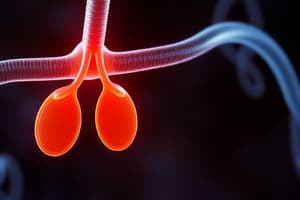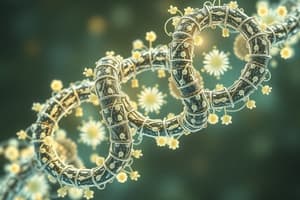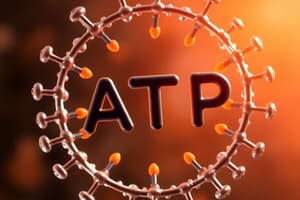Podcast
Questions and Answers
¿Cuál de las siguientes afirmaciones sobre el ATP es correcta?
¿Cuál de las siguientes afirmaciones sobre el ATP es correcta?
- El ATP no contiene grupos fosfato en su estructura.
- El ATP es la principal moneda energética de todas las células vivas. (correct)
- El ATP se forma únicamente durante la fotosíntesis.
- El ATP se utiliza principalmente para almacenar información genética.
¿Qué componente del ATP se considera un azúcar de cinco carbonos?
¿Qué componente del ATP se considera un azúcar de cinco carbonos?
- Ribosa (correct)
- Fosfato
- Adenina
- ADP
¿Qué ocurre durante la hidrólisis del ATP?
¿Qué ocurre durante la hidrólisis del ATP?
- Se produce ATP a partir de ADP.
- Se rompe un enlace fosfato y se libera energía. (correct)
- Los grupos fosfato se unen para formar ADP.
- El ATP se convierte en ribosa y adenina.
¿Cuál es la función principal de la adenina en el ATP?
¿Cuál es la función principal de la adenina en el ATP?
¿Qué sucede cuando se rompe un enlace fosfato en el ATP?
¿Qué sucede cuando se rompe un enlace fosfato en el ATP?
¿Cuál es el proceso a través del cual el ADP se convierte nuevamente en ATP?
¿Cuál es el proceso a través del cual el ADP se convierte nuevamente en ATP?
¿Qué función tiene el ATP en la contracción muscular?
¿Qué función tiene el ATP en la contracción muscular?
¿Qué papel juegan los grupos fosfato en el ATP?
¿Qué papel juegan los grupos fosfato en el ATP?
Flashcards
Función de ATP
Función de ATP
El ATP es la principal fuente de energía para las células vivientes, transportando energía química en sus enlaces fosfato.
Hidrólisis del ATP
Hidrólisis del ATP
Proceso de ruptura del ATP mediante la adición de agua, liberando energía al separarse un grupo fosfato.
Regeneración del ATP
Regeneración del ATP
Proceso de reconstrucción del ATP a partir de ADP y un grupo fosfato utilizando la energía de los procesos celulares.
Componentes del ATP
Componentes del ATP
Signup and view all the flashcards
Enlaces de alta energía del ATP
Enlaces de alta energía del ATP
Signup and view all the flashcards
ATP y proceso celular
ATP y proceso celular
Signup and view all the flashcards
ADP
ADP
Signup and view all the flashcards
Ribosa en el ATP
Ribosa en el ATP
Signup and view all the flashcards
Study Notes
ATP: Adenosine Triphosphate
- ATP is a crucial molecule for storing and transferring energy within cells.
- It's the primary energy currency of all living cells.
- ATP carries chemical energy in its phosphate bonds.
Structure of ATP
-
ATP consists of three main parts:
- Adenine: A nitrogenous base.
- Ribose: A five-carbon sugar (ribose).
- Three phosphate groups: Linked together via high-energy phosphate bonds.
-
The bonds between phosphate groups are unstable and easily broken.
-
Breaking these bonds releases energy that cells can use for various processes.
ATP Hydrolysis
- Hydrolysis is the process of breaking down ATP through the addition of water.
- The removal of one phosphate group from ATP results in Adenosine Diphosphate (ADP) and a free phosphate ion (Pi).
- This reaction releases a significant amount of energy.
ATP Regeneration
- ATP is constantly being utilized and needs to be regenerated.
- The energy released from cellular processes, such as respiration, is used to reattach a phosphate group to ADP, reforming ATP.
- This regeneration process is vital for sustaining cellular functions and processes.
ATP's Role in Cellular Processes
- ATP powers numerous cellular processes, including:
- Muscle contraction: Providing the energy required for muscle movement.
- Active transport: Moving molecules across cell membranes against their concentration gradients.
- Biosynthesis: Fueling the creation of complex molecules.
- Nerve impulse transmission: Crucial for nerve signal propagation.
- Cell division: Supporting the energy demands of cell replication.
Other Energy Systems (related to but distinct from ATP)
- While ATP is the primary energy currency, other biochemical processes exist that involve energy release and storage.
- Anaerobic and aerobic respiration create ATP and utilize different energy pathways which interact with ATP.
- These alternative energy systems often function alongside ATP systems and can be crucial for different cellular states or activities.
Adenosine
- Adenosine is a nucleoside, formed from adenine and ribose. (It is not the same as ATP directly)
- It plays a role as a neuromodulator in the central nervous system, influencing wakefulness and other functions.
Riboses
- Riboses are pentose sugars involved in nucleic acids (RNA and DNA).
- The ribose sugar in ATP is critical to the structure and function of ATP.
Phosphate Groups
- Phosphate groups are involved in energy transfer and storage in ATP.
- The high-energy phosphate bonds are crucial for the storage and release of energy by ATP.
- The negative charges on the phosphate groups contribute to the instability of the bonds and ease of energy release.
Studying That Suits You
Use AI to generate personalized quizzes and flashcards to suit your learning preferences.




